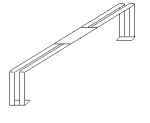First of all I am new to this group, and have been rummaging through the posts on here looking for answers before posting. I have not seen anything so I figured I would ask. Also if this is not the correct forum please move to the correct one. Also I have been a handheld user of VHF for almost 10 years, however just in the last year have been getting more into the installations and antennas, so I am not new to the use but the how it works a little more so. (Please be gentle  )
)
First off I have a 2014 F150 Supercrew, pass through console, and power everything, which is great as well as a great PITA (for installation purposes).
Second off, I am going to be running a stake post mount for a VHF/UHF mobile (model yet to be determined, leaning to a Yeasu or ICom remote head unit, any recommendations are also very much appreciated)
Thirdly I am trying to avoid drilling as much as possible on my truck, ie holes in the roof, cab walls etc - tall order I know but not impossible.
Without further ado here is my thoughts and questions.
I am wanting to install the radio itself under the front passenger seat, however I have power seats in the front and not sure of the space available or if the power seats will give me interference RX or TX? The console is not going to be a viable option as I have a vault and all my off road and emergency lights wired through it as well as other equipment. The backseat area is possible, however most of the back of the cab area is used for the furball soon to be furballs.
Also would a hood mount antenna work better than a stake pocket mount (going to be adding a shell)?
I am open to suggestions and will appreciate all the input and suggestions. The commo gear is not set in stone yet, but I have been trying to get everything ready before I just jump into installation.
Thanks in advance!
Jerry
KL3CK
First off I have a 2014 F150 Supercrew, pass through console, and power everything, which is great as well as a great PITA (for installation purposes).
Second off, I am going to be running a stake post mount for a VHF/UHF mobile (model yet to be determined, leaning to a Yeasu or ICom remote head unit, any recommendations are also very much appreciated)
Thirdly I am trying to avoid drilling as much as possible on my truck, ie holes in the roof, cab walls etc - tall order I know but not impossible.
Without further ado here is my thoughts and questions.
I am wanting to install the radio itself under the front passenger seat, however I have power seats in the front and not sure of the space available or if the power seats will give me interference RX or TX? The console is not going to be a viable option as I have a vault and all my off road and emergency lights wired through it as well as other equipment. The backseat area is possible, however most of the back of the cab area is used for the furball soon to be furballs.
Also would a hood mount antenna work better than a stake pocket mount (going to be adding a shell)?
I am open to suggestions and will appreciate all the input and suggestions. The commo gear is not set in stone yet, but I have been trying to get everything ready before I just jump into installation.
Thanks in advance!
Jerry
KL3CK







